Durst F. Fluid Mechanics: An Introduction to the Theory of Fluid Flows
Подождите немного. Документ загружается.

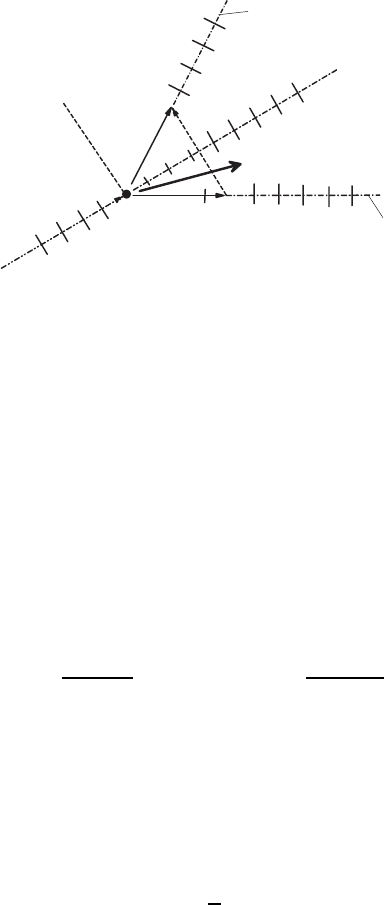
21.7 Laser Doppler Anemometry 695
Observer A
Instantaneous velocity
of particle
{U
i
}
Observer B
Direction of measured
velocity component
{
k
i
}
{m
i
}
Scattering particle
Light beam from
laser li
g
ht source
{
l
i
}
Fig. 21.34 Considerations of the Doppler shifted frequency of the scattered light
of the particles. This is the basis of optical velocity measurement by means
of laser Doppler anemometry.
In Fig. 21.34, an arrangement of laser beams is shown, which is suited for
explaining the LDA measurement principle. A beam, emanating from a laser-
light source, has the beam direction {!
i
} = !
i
and hits a scattering particle
which scatters light in all directions in space, and consequently also in the
directions which are given by the vectors {k
i
}= k
i
and {m
i
} = m
i
.The
moving scattered particle has the velocity {U
i
} = U
i
and therefore scatters
light having a Doppler shift of the frequency. In the two directions of the
receivers A and B, given by the direction vectors k
i
and m
i
, the frequencies
can be derived as
ν
A
= ν
c − U
i
!
i
c − U
i
k
i
and ν
B
= ν
c − U
i
!
i
c − U
i
m
i
(21.87)
Here, the particle generating the scattering beams once acts as a moving re-
ceiver of the arriving laser radiation and at the same time also as a moving
transmitter of the scattered radiation, i.e. the Doppler effect has to be ap-
plied twice, in order to deduce the relationships in (21.87). The simultaneous
detection of the two light signals by observers A and B allows one to detect
the frequency difference:
∆ν = ν
A
− ν
B
=
1
λ
U
i
(k
i
− m
i
) (21.88)
by superposition of the scattered waves. This superposition is carried out
in order to determine the velocity of the scattering particles by a frequency
detectable by available photo detectors.
This superposition of the two waves is carried out since direct measurement
of the frequencies ν
A
and ν
B
, which according to (21.87) already show the
desired velocity dependence, is not possible, as the frequencies to be detected
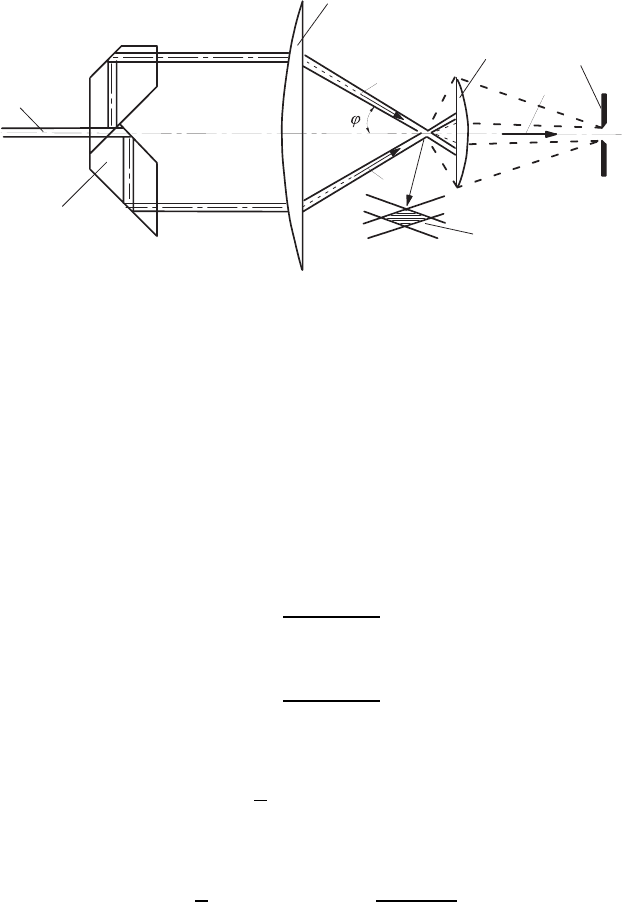
696 21 Introduction to Fluid-Flow Measurement
Lens
Lens
Pinhole
Light beam
from laser
Beam Spliter
Interference fringes
measuring volume
k
i
l
1
l
2
Fig. 21.35 Diagram of optical set-up of a two-beam LDA system
are in the range of 10
15
Hz. Moreover, there is no detection system having the
frequency resolution to measure relative to 10
15
Hz, the frequency of the laser
radiation, the Doppler shift, which is around 2 ×10
5
Hz m
−1
s. It is therefore
necessary to determine the velocity-dependent Doppler shift of the laser light
from the frequencies of two scattered light signals that can be superimposed.
This leads to the introduction of the two-beam anemometer, as shown in
Fig. 21.35. A first summary of the early work in Laser Doppler anemometry
is given by Buchhave et al. [21.3].
When applying the above derivations to the optical set-up in Fig. 21.35, one
obtains in each direction given by the vector k
i
the following two frequencies:
ν
1
= ν
c − U
i
(!
1
)
i
c − U
i
k
i
(21.89)
and
ν
2
= ν
c − U
i
(!
2
)
i
c − U
i
k
i
(21.90)
From this, the difference frequency can be computed, for c | U
i
|:
∆ν =
1
λ
U
i
[(!
2
)
i
− (!
1
)
i
] (21.91)
This yields for the frequency difference:
∆ν =
1
λ
U
i
[(!
2
)
i
− (!
1
)
i
]=
U
⊥
2sinφ
λ
, (21.92)
where λ is the wavelength of the laser light U
⊥
the velocity component vertical
to the axis of the optical system and ϕ half the angle between the scattering
beams. This relationship shows that the suspended frequency is independent
of the direction of observation. This is a big advantage when employing this
optical system, since a large collecting aperture of the receiving optical system
can be employed to detect the scattered light signal.
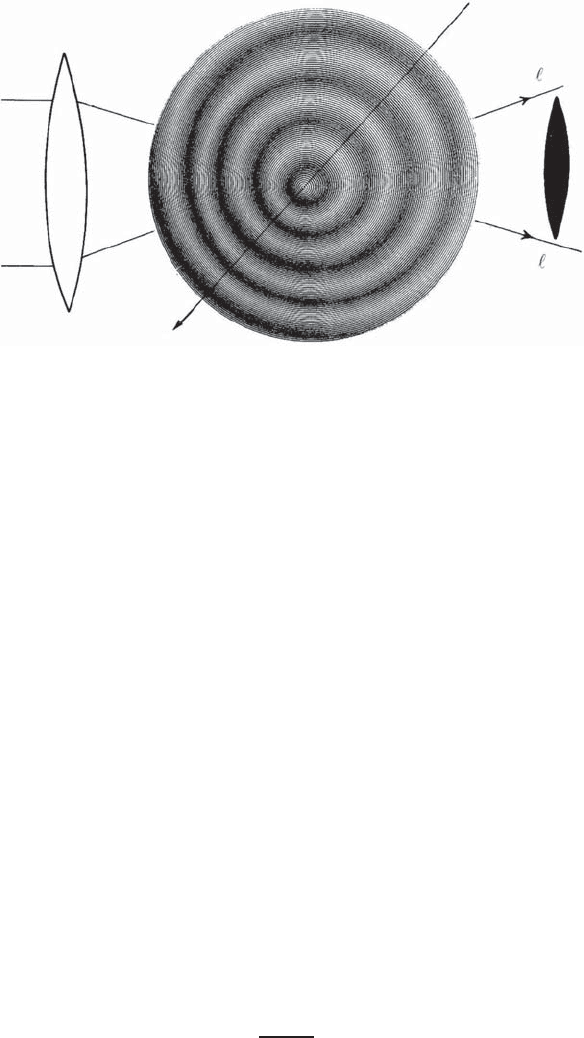
21.7 Laser Doppler Anemometry 697
Laser beam 1
1
2
{
}
{
}
i
i
U
{
}
i
Laser beam 2
Fig. 21.36 Visual representation of LDA signals by transparents
In Fig. 21.36, an attempt is made to represent visually, by means of a
method developed by Durst and Stevenson [21.4], the above light superpo-
sition processes which lead to the desired frequency difference, in order to
measure f
D
= ∆ν. Figure 21.36 shows the two laser beams of the optical
velocity-measuring instrument and also a moving scattering particle which
was assumed to be present in the measurement volume. This figure also
shows scattering waves and the lens of the receiving optical system, which is
needed for detecting the scattering light. When superimposing on the scat-
tered wave of the first laser beam the second scattered wave of the second laser
beam, then, due to the different frequencies of the two scattering beams, the
frequency difference becomes detectable by means of a photodetector. This
detector yields an electrical signal proportional to the light intensity varia-
tions whose frequency is a measure of the velocity of the particle generating
the two scattered waves. The velocity component vertical to the axis of the
optical system, i.e. perpendicular to the bisector of the two laser beams, is
measured. The measured velocity component is located in the plane set up
by the two laser beams.
The above-explained physical processes of optical velocity measurements
by means of laser beams can also be explained by means of the so-called
interference model; see Fig. 21.37. This model starts from the assumption
that in the intersection volume of the two laser beams, interference fringes
are produced, whose fringe distance is given by the geometry of the optical
set-up and the wavelength of the laser light:
∆x =
λ
2sinϕ
(21.93)
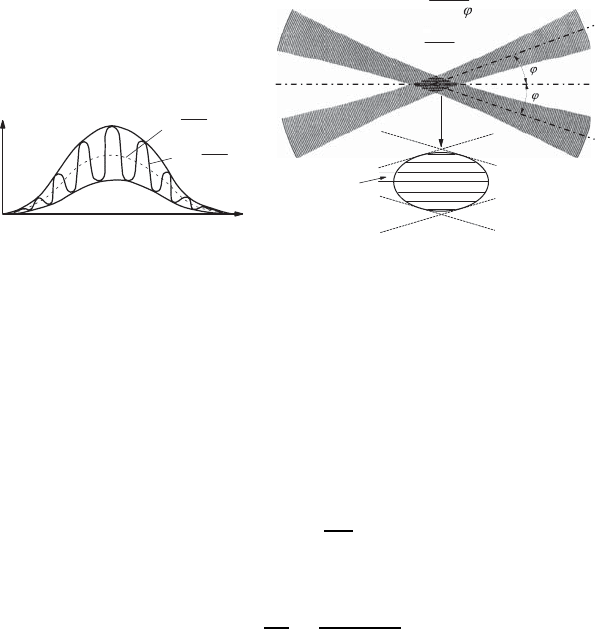
698 21 Introduction to Fluid-Flow Measurement
Interference fringes
in the crossing region
of laser beams
∆
x
f
=
U
⊥
2 sin
∆
x
∆
x
=
λ
I(
x
)
x
I
m
=
I
1
+
I
2
2
I
R
=
2
I
1
-
I
2
The modulation
I
(
x
)
depends
on the light intensity differences
of the beams
Fig. 21.37 Visual representation of the interference fringes in the measuring volume
of a laser Doppler anemometer
When a scattered particle is moving through this interference pattern, it
will scatter light whose intensity, for a sufficiently small particle diameter,
is proportional to the local light intensity in the measuring volume. Because
of this, the intensity of the scattered light shows sinusoidal fluctuations that
are caused by the motion of the particle through the interference pattern.
When the particle has a velocity component U
⊥
perpendicular to the plane
representing the interference fringes, the moving particle needs the following
time to cross a single fringe:
∆t =
∆x
U
⊥
(21.94)
This brings about a signal frequency which can be expressed as follows:
f =
1
∆t
=
U
⊥
2sinϕ
λ
(21.95)
These considerations lead to the same final equation as was derived above
with the help of a Doppler model. In Fig. 21.37, in turn, the modeling of
Durst and Stevenson [21.4] is included, in order to explain the interference
pattern in the measuring volume. Parallel interference fringes are present in
the crossing region of the two incident beams, as explained above, and they
are made visible.
To understand fully the signals occurring in optical velocity measurements,
attention has to be given also to the fact that the incident beams have a
finite expansion perpendicular to their direction of propagation and that their
intensity distribution over the cross-section shows a Gaussian distribution.
When taking this into account, it is understandable that a particle, that
passes through the center of the measuring volume of an LDA system, brings
about a signal as shown in Fig. 21.37.
When a particle is moving through the measuring volume of an LDA
system, a little away from the center, due to the locally existing intensity
differences of the two crossing beams, signals are to be expected as indicated
in Fig. 21.38. A signal which originates from a particle that moved through
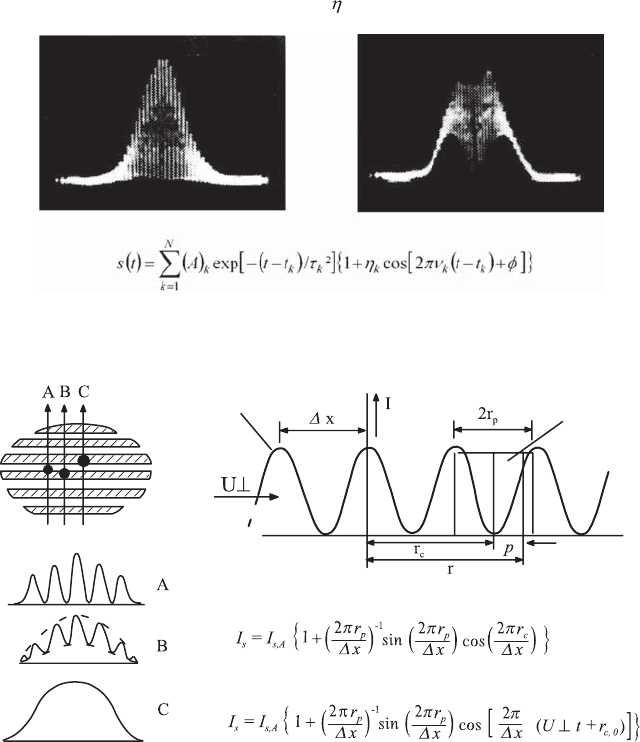
21.7 Laser Doppler Anemometry 699
Analytical presentation of LDA-Signals
(
A
)
k
= Amplitude of
k
-th signal
k
= Modulation depth of
k
-th signal
Fig. 21.38 Analytical representation of LDA signals
Intensity distribulion
of laser light in
measuring volume
Scattering
particle
Intensity distribution as a function of particle size:
Intensity of LDA-signal
Fig. 21.39 Different modulation depths with laser Doppler signals
the center of the volume, showing a good signal modulation, serves for com-
parison. Here, the two beams are located in the same plane, and they can
therefore be considered as overlapping well. Away from the center the parti-
cle crosses first one beam, then the overlapping area of the two beams and
finally the area of the second beam. The LDA signal in Fig. 21.39 reflects this
final form of the signal.
The influence of the particle size is shown in Fig. 21.39. When particles are
very small, they do not integrate the interference pattern in the measurement
of volume, i.e. the modulation depth of the intensity distribution of the inter-
ference pattern is fully reflected in the scattering signal of a particle. In this
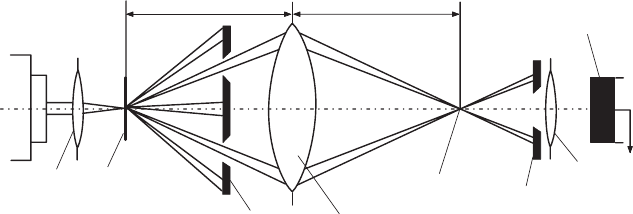
700 21 Introduction to Fluid-Flow Measurement
way a signal forms as is shown by the LDA-signal in (A). When the diameter
of a particle is increased, a signal shape develops as sketched in (B). When
the particle corresponds to the size of the distance of the interference fringes,
it is possible that the modulation disappears completely (C). In Fig. 21.39,
equations are given that show these relationships, for a particle assumed to
be square for the considerations carried out here. This form of the particles
is sketched and it is assumed to be moving through the interference pattern.
As far as the determination of the particle velocity direction is concerned,
some additional explanations are necessary. The explanations of optical
velocity measurements given so far, do not permit different signals to be gen-
erated for particles with the same velocity, but different velocity directions.
Therefore, a particle that moves in one direction through the interference
pattern in Fig. 21.37, will yield the same signal as a particle moving in the
opposite direction, having the same velocity. If, however, one changes the
frequency of a laser beam by a certain amount, this leads to a moving in-
terference pattern in the measuring volume. This can be explained in the
simplest way, when looking at the optical system in Fig. 21.40. It consists of
a diffraction grating, which is employed for splitting one laser beam. The two
beams of first order are made, with the help of a lens, to cross one another in
the measuring volume. There, in turn, one can imagine the interference-fringe
pattern required for the laser Doppler measurements. This means that the
coherence of the two crossing laser beams is maintained.
The interference fringes forming in the measuring volume can be viewed
as an image of the grid lines present on the diffraction grating, and with this
it can be understood that a rotation of the diffraction grating brings about
a motion of the interference fringes in the measuring volume. Here, emphasis
has to be laid on the fact that it is not the entire measuring volume that
moves, but only the intensity changes continuously in the measuring volume
with time. This means that only the interference pattern moves and not the
measuring volume. When a particle is now moving in the same direction as
the interference pattern, a smaller frequency is measured than with a motion
directed against the motion of the frequency pattern. When one knows the
Lens
Rotating
grating
Pinhole
Lens
Lens
Measuring volume
Photo detector
l
1
l
2
Pinhole
Fig. 21.40 Diagram of a laser Doppler system based on a rotating diffraction grating
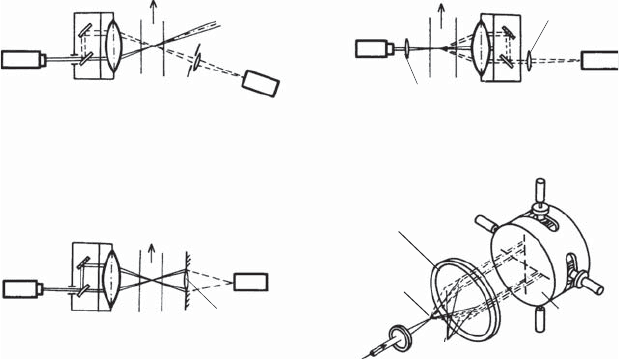
21.7 Laser Doppler Anemometry 701
motion velocity of the interference fringes, which is given by the rotation of
the diffraction grating, the relative motion can be determined and, hence, also
the sign of the measured velocity component. Simple and easy to understand
introductions into the LDA-measuring technique are provided in references
[2.5] and [2.7].
21.7.2 Optical Systems for Laser Doppler
Measurements
The insights gained in the first decade of developments in laser Doppler
anemometry, have led to different optical setups for functioning laser Doppler
systems. All of them can be employed for contact-free velocity measure-
ments in flowing fluids. Many available optical systems can be subdivided
into three main groups which nowadays are designated as reference-beam
anemometer, two-beam anemometer and two-scattering-beam anemometer;
see Fig. 21.41. Practical employment of these instruments has shown that the
first LDA system shown above, is suitable especially for measurements in
very soiled fluids, where high particle concentrations are present and multi-
ple particles are present in the measuring volume. The second system, the
two-beam anemometer, is particularly suited for measurements, where the
particle concentration is such that, on average, there is less than one particle
in the measuring volume. This can be expected in all liquid flows and gas
flows that appear completely transparent to the human eye.
Fluid flow
Integrated
optical system
Fluid flow
Fluid flow
PM
PM
PM
Integrated
optical system
Integrated
optical system
Laser
Lens
Laser
Reference beam anemometer
Two-beam anemometer
Two scattered beam anemometer
Measuring
volume
Collecting lens
Laser light
Mask with
adjustable
slot
Collected light
detected by the
photodetector
Lens
Lens
Lens
Fig. 21.41 Reference-beam, two-beam and two-scattering-beam optical systems for
laser Doppler measurements

702 21 Introduction to Fluid-Flow Measurement
Beam splitter module
Bragg cell module
Prism module
Laser
Fluid flow
Lens
Collecting lens
Photo detector
Test section
Fig. 21.42 Optical elements of a two-beam laser Doppler anemometer
When a laser beam passes through a fluid, the laser beam generally lights
up intensely and this indicates that there are particles in a range that can-
not be observed by the human eye and which are about a few µm in size.
These particles are suited for velocity measurements with the help of a laser
Doppler system and the two-beam method is particularly suited for reliable
measurements. The two-scattering laser beam method needs to be employed
only in special cases, when measurements of two velocity components have
to be carried out with simple means.
In Fig. 21.42, the essential elements of a two-beam LDA system are shown.
From this diagram, it can be deduced that the optical transmitter system
is essentially composed of the laser light source and a beam-splitter unit,
followed by a lens. A frequency-shifting unit, consisting of Bragg cells, is also
included for measuring the direction of the flow. For the collection of the light,
another lens and a photomultiplier, with an appropriate pinhole, are required.
In the intersection region of the two beams of this optical set-up, one can
imagine that the interference fringes, explained in Sect. 21.7.1, form for the
actual measurements. To obtain good LDA signals, it is essential that these
interference fringes are fully modulated, i.e. that intensity becomes zero in the
dark part of the interference fringe pattern. This can be achieved by matching
the intensities of the two beams, and in addition by employing optimal optical
systems, i.e. optical systems with the same optical pathlengths of the two
beams. This latter requirement yields in the measuring volume to zero phase
differences of the superimposed laser-light waves.
For precise laser Doppler measurements, it is necessary to choose the cor-
rect laser. As most lasers have an outlet showing several axial modes, it
is necessary to keep the optical pathlengths of the two laser beams of the
system to be almost the same. This is guaranteed by employing an optical
beam-splitting prism, as indicated in Fig. 21.42. This prism has further ad-
vantages that recommend it for employment for practical measurements. It
is insensitive to adjustment and, hence, rotation of the prism in the plane,
as shown in Fig. 21.42, does not lead to a directional change of the parallel
beams leaving the prism. These beams are always parallel to the incident
beam and always have the same distance in relation to the optical axis of the
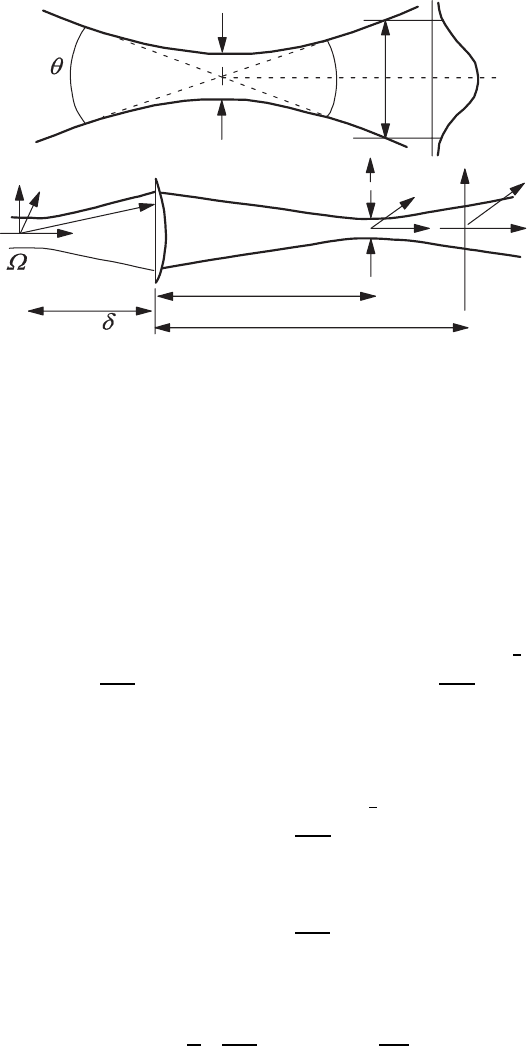
21.7 Laser Doppler Anemometry 703
η
ζ
ξ
z
2
w
0
R
(
z
)
2
s
(
z
)
y
x
z
z
x
y
s
P
P
0
d
min
d
P
L
Fig. 21.43 Sketch of laser beams to explain the Gaussian beam behavior in optical
systems
system. By choosing the prism shown in Fig. 21.42, LDA instruments become
insensitive to adjustment and are suited for practical flow investigations.
Laser beams show a behavior that is usually referred to as that of a Gaus-
sian beam (Fig. 21.43). For f →∞and ρ
L
→∞, one can derive from
relationships, as indicated by Durst and Stevenson [21.4], analytical expres-
sions for the variation of the wave-front curvature R(z) and the beam radius
s(z):
R (z)=z
3
1+
πω
2
0
λz
2
4
and s (z)=ω
0
3
1+
λz
πω
2
0
2
4
1
2
(21.96)
With the help of these equations, the radius of the two beams and the wave-
front curvature at the lens of an LDA system can be computed:
σ
L
= ω
0
3
1+
λz
πω
2
0
2
4
1
2
(21.97)
and
ρ
L
= δ
3
1+
πω
2
0
λσ
2
4
(21.98)
The expression for the light intensity is
I
p
(r)=
2
π
πω
0
fλ
2
P
L
exp
−
2r
2
s
2
(21.99)

704 21 Introduction to Fluid-Flow Measurement
The influence of the properties of focused Gaussian beams on the mode
of operation of laser Doppler anemometers was investigated by Durst and
Stevenson [21.4] and Hanson [21.2]. When using a single lens to focus the
two incident beams, as is usually the case in two-beam systems, the axes of
the beams cross one another in the focal region of the lens. When the beam
waists are not adjusted to this region, this has an increased measuring volume
as a consequence. In addition, it could be shown by Durst and Stevenson [21.4]
that the curvature of the wave fronts, which occurs inside the crossing region
of the two beams, can lead to significant changes of the Doppler frequency,
when the particles traverse different parts of the measuring volume. If prop-
erly set up LDA systems are employed, the mentioned effects are often very
small and they were usually ignored in fluid flow measurements with laser
Doppler anemometers, either because they were not known, or because the
advantages of a set-up with a single lens outweighed these small discrepan-
cies. For some applications, e.g. in laser Doppler measurements over large
distances, investigations in extended flow fields, etc., the indicated errors can
be of significance, so that appropriate steps have to be taken to ensure an
optimal beam intersection region. This can be achieved in two ways:
• The waists of the two laser beams are laid into the back focal region of
the transmitter lens of the LDA optical system.
• An additional optical component, consisting of a convex and a concave
lens, is put between the laser and the lens of the LDA optical system. This
system is used for choosing freely the position of the beam contraction
with regard to the main lens of the optical system.
The above means that, to carry out now reliable LDA measurements, one
has to ensure that the beams in the measuring volume of a laser Doppler
anemometer are focused in such a way that we obtain parallel interference
fringes, with a high modulation depth, i.e. the minimum of the light intensity
should almost be zero. As far as the optical set-up of an LDA system is
concerned, the following should be mentioned:
• The lens in front of the photodetector has to be chosen such that the
equation:
d
ph
=
N
ph
Mλ
2sinϕ
(21.100)
holds, where d
ph
is the number of interference fringes which the photo
multiplier sees, M is the optical enlarging relation of the detection system
(M = b/a), λ the wavelength of the laser light and ϕ is half the angle
between the two incident laser beams.
The diameter of the effective measuring volume can then be calculated as:
d
m
=
d
ph
M
= ∆xN
ph
=
λN
ph
2sinϕ
(21.101)
